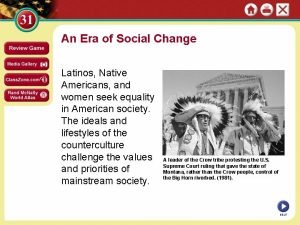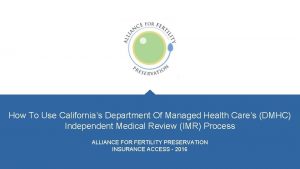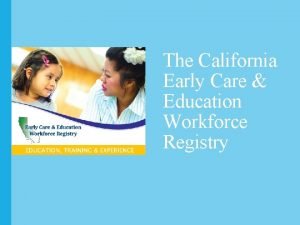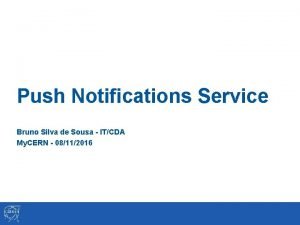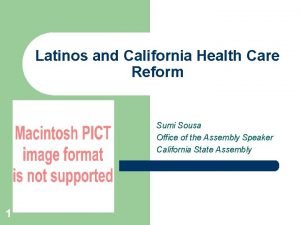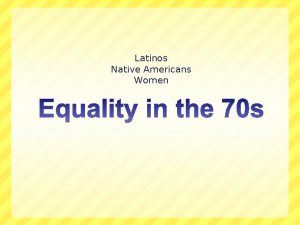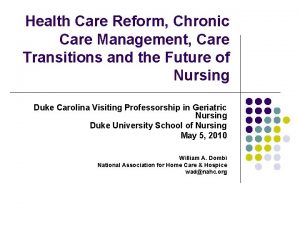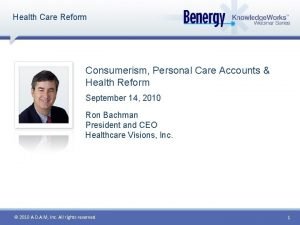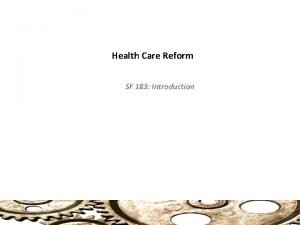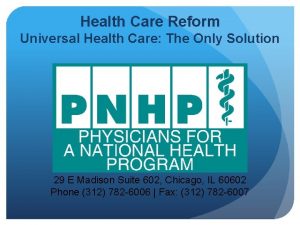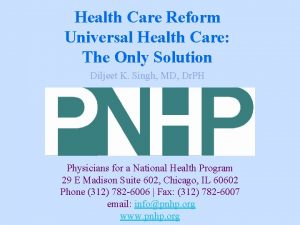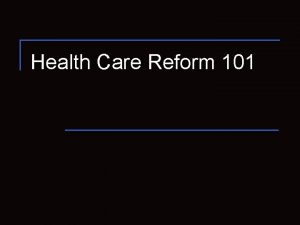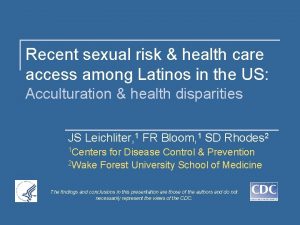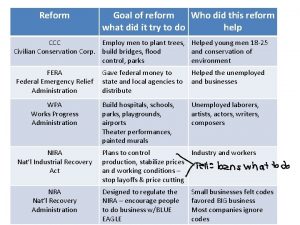Latinos and California Health Care Reform Sumi Sousa
















- Slides: 16

Latinos and California Health Care Reform Sumi Sousa Office of the Assembly Speaker California State Assembly 1

Context l What happens with the Latino population drives CA. – – – l l 2 Latinos constitute 35% of CA residents Latinos will become the largest race/ethnic group in CA by 2011 Latinos will constitute 52% of CA’s population by 2042. 6. 7 M non-elderly Californians are uninsured for all or part of the year. 60% are Latino. 1 in 3 Latinos in California is uninsured.

Context l California embarked upon a serious health care reform effort in 2007 -08, wanting to address: – – – l Short window of opportunity – 3 Unsustainable growth in the cost of health care The large and growing population of uninsured and related problems of health care access Dysfunctional individual market Prevention agenda Improvements to the overall health care delivery system – Republican Governor in mid-2006 says 2007 will be “Year of Health Care Reform” CA’s 2/3 vote requirement for taxes and 2008 elections meant a deal must be struck by the end of 2007/early 2008.

Context l Significant constraints related to financing – – l Significant Political Constraints – – 4 2/3 vote requirement for taxes ERISA Children’s health ballot initiative had just been defeated in 11/06 Previous, more modest reform attempt had been defeated in 2004 2/3 vote requirement meant Governor had no Republican votes Politics of immigration

What Would AB 1 x Have Done? l l l 5 Established a system of near universal coverage. Employer and individual responsibility: Pay or play with an individual mandate Established a purchasing pool for workers in firms not offering coverage and tax credits (subsidies) for coverage for lower income workers. Individual market reforms, including guarantee issue. 85/15 medical loss ratio Major public program expansions (Medi-Cal and Healthy Families) for low-income Californians, including childless adults.

What Would AB 1 x Have Done l l 6 $2. 3 B Medi-Cal rate increase funded via a 4% quality improvement fee assessed on hospitals Public Health and Prevention Programs: Obesity, diabetes, tobacco cessation $1. 75 per pack increase in the tobacco tax Scope of practice changes to increase supply and availability of health care providers

How Would It Have Affected/Why Was It Important for Latinos? l l l 7 Coverage Affordability Access Prevention/Public Health Workforce

Coverage l l 1 in 3 Latinos is uninsured in CA Uninsured in CA are largely low income workers. – – – l So structure of the employer “Pay or Play” important for Latinos. – – l Minimum spending requirement of 1% - 6. 5%, depending on payroll size Purchasing pool w/ the available tax credit meant there was a place for lower income families to purchase comprehensive, affordable coverage Contained a major expansion of the state’s Medi-Cal and Healthy Families (SCHIP) programs. – 8 84% of the uninsured in CA are workers and their family members Latinos work in firms with the lowest offer rates amongst all groups in CA – 70% (for ex. , whites = 90. 2%). They have one of the lowest take up rates in CA – 80%. – Medi-Cal and Healthy Families expansion would have covered California’s 800, 000 low income uninsured children regardless of documentation status. Undocumented children are 4. 1% of all children in CA and 18. 5% of uninsured children.

Coverage l Coverage program for remaining uninsured adults (ineligible for the pool or any public programs), via state’s non-profit community clinics. – Significant expansion of an existing state-only program which funds primary care services to low income uninsured adults. – l Gruber estimates that AB 1 x would have resulted in 71% of California’s uninsured gaining coverage, and an overall coverage rate of 98% of documented adults and 100% of children in CA. – 9 Undocumented adults 19 – 64 are 8. 9% of all adults and 25. 3% of uninsured adults in CA. Individual mandate exempted people below 250% of FPL whose premiums would have been greater than 5% of income – essentially, the undocumented.

Affordability l l l 41. 1% of CA’s non-elderly population have incomes below 250% of FPL. 61. 6% of the Latino non-elderly population have incomes below 250% of FPL, 80. 3% have incomes below 400% of FPL. In addition to public program expansion which ensure free or very low cost coverage, AB 1 x contained significant affordability provisions for lower income workers. – – Required establishment of Sect. 125 plan Purchasing pool for non-offering employers Advanceable, refundable tax credit via the purchasing pool for those 250% - 400% of FPL. Favorable cost sharing for products offered in the pool l 10 l Incomes up to 150% = 0 cost sharing Incomes 150% - 250%, premiums limited to 5% of income.

Access • • More than half of uninsured children in CA are eligible for public coverage. 68% of the eligible but unenrolled are Latino. So enrollment simplification measures for Medi-Cal and Healthy Families, including elimination of the asset test, changing of the deprivation standard and simplification of the semi-annual status report are particularly important for Latinos. Increased income limits to 300% of FPL for kids. $2. 3 B Medi-Cal rate increase for CA’s hospitals and physicians – – 11 CA’s low reimbursement rates have created a serious access problem for recipients. 53% of all Medi-Cal recipients are Latino.

Prevention • The Community Makeover Grants - Obesity Prevention – – l 12 Grants for all the state’s local public health officers for purposes of healthy eating, living, and overall obesity prevention. Particularly focused on changing environmental and lifestyle factors, such as gaining access to fresh foods, location of supermarkets in urban core, open space for physical activity. Nearly 7 out of 10 Latino adults in California is overweight or obese.

Prevention l Diabetes – – 13 Created the CA Diabetes Prevention Program within Medi. Cal to provide diabetes prevention and management services to all adult fee for service Medi-Cal recipients Similar to obesity prevention programs, focused on education, prevention and lifestyle changes. Would have worked with health plans and providers on incorporating culturally and linguistically appropriate lifestyle coaching, self-management, in addition to clinical interventions. Diabetes prevalence is 8% for Latinos adults overall in CA. However 21% of Latino adults age 50 – 64 have diabetes, the highest amongst any race or ethnicity for this age group.

Prevention l Tobacco cessation – – 14 California has been a leader in tobacco education and prevention AB 1 x contained an expansion of existing tobacco cessation programs, including Smoker’s Helpline which is available in 6 languages. Allowed community clinics to bill for smoking prevention and cessation as a part of primary care services. Tobacco tax = additional $1. 75 per pack (current taxes = 87 cents per pack)

Workforce l l l 15 CA faces a severe shortage of health care professionals, particularly in rural and low-income areas of the state. There’s an even greater shortage of minority health care professionals. AB 1 x would have established a scope of practice in law for nurse practitioners and expanded their ability to supervise medical assistants in clinical settings other than community clinics. AB 1 x also contained money for health care workforce training programs in Los Angeles County that incorporated more minorities into the health care professions.

Latinos Have A Huge Stake in Health Care Reform l l 16 Both at the state and national level, Latinos have much to gain in health care reform. Important that future policy decisions related to health care reform, particularly in the area of affordability and prevention, pay close attention to the demographic trends of this population.
 Latinos and native americans seek equality
Latinos and native americans seek equality Department of managed health care california
Department of managed health care california Quadrados latinos sudoku
Quadrados latinos sudoku Ojos latinos
Ojos latinos Health and social component 3
Health and social component 3 Health and social care unit 2
Health and social care unit 2 Continuum of care reform
Continuum of care reform Types of care primary secondary tertiary
Types of care primary secondary tertiary Ca ece workforce registry
Ca ece workforce registry Miguel sousa neves
Miguel sousa neves Estrutura interna e externa de frei luis de sousa
Estrutura interna e externa de frei luis de sousa Espectro bipolar sintomas
Espectro bipolar sintomas Philip
Philip Aristides de sousa mendes angelina ribeiro
Aristides de sousa mendes angelina ribeiro Bruno cda
Bruno cda Luis almeida e sousa
Luis almeida e sousa Jocerlano santos de sousa
Jocerlano santos de sousa
